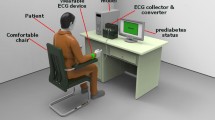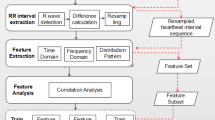Abstract
An automated diagnostic system for diabetes mellitus (DM), from heart rate variability (HRV) measures, using feed forward neural network has been developed. Changes in autonomic nervous system activity caused by DM are quantified by means of time domain and frequency domain analysis of HRV. Electrocardiograms of 70 DM patients and 65 healthy volunteers were recorded. Nine time domain measures—standard deviation of all NN intervals, square root of mean of sum of squares of differences between adjacent NN interval (RMSSD), number of adjacent NN intervals differing more than 50 ms. (NN50 count), percentage of NN50 count, R-R triangular index, triangular interpolation of NN intervals (TINN), standard deviation of the mean heart rate, mean R-R interval and mean heart rate—were used as the input features to the neural network. This diagnostic system classifies DM patients and normal volunteers from morphologically identical ECGs. Diagnostic results show that the system is performing well with an accuracy of 93.08%, specificity of 96.92% and sensitivity of 89.23%.


Similar content being viewed by others
References
Sztajzel, F., Heart rate variability: A noninvasive electrocardiographic method to measure the autonomic nervous system. Swiss Med. Wkly 134:514–522, 2004.
John, D., and MacArthur, C. T., Heart rate variability. Research Network on Socioeconomic Status and Health-Article, 1997.
Perciaccante, A., Fiorentini, A., Paris, A., Serra, P., and Tubani, L., Circadian rhythm of the autonomic nervous system in insulin resistant subjects with normoglycemia, impaired fasting glycemia, impaired glucose tolerance, type 2 diabetes mellitus. BMC Cardiovasc. Disord. 6:19, pp. 1–10, May 2006.
Al-Hazimi, A., Al-Ama, N., Syiamic, A., Qosti, R., and Abdel-Galil, K., Time—Domain analysis of heart rate variability in diabetic patients with and without autonomic neuropathy. Ann. Saudi Med. 22(5–6):400–403, 2002.
Geevarghese, P. J., Abraham, A. K., Annie, P. A., In: Geevarghese, P. J. (Ed.), A Hand Book for Diabetics. 8th Edition. Cochin, India, pp. 8–9, 1999.
Wild, S., Roglic, G., Green, A., Sicree, R., and King, H., Global prevalence of diabetes—Estimates for the year 2000 and projections for 2030. Diabetes Care 27(5):1047–1053, 2004.
Thayyil, G., Diabetics in children. Mathrubhumi Daily, Calicut, p. 4, 2008.
Diabetes Neuropathy (Nerve Damage) and Diabetes. Pfizer, American Diabetes Association, Article, pp. 1–2, May 2007.
Jelinek, H., Flynn, A., and Warner, P., Automated assessment of cardiovascular disease associated with diabetes in rural and remote health care practice. The National SARRAH Conference, pp. 1–7, 2004.
May, O., Arildsen, H., and Moller, M., Parasympathetic function during deep breathing in the general population: Relation to coronary risk factors and normal range. J. Intern. Med. 245:287–294, 1999.
Nathan, D. M., Clary, P. A., Backlund, J. Y., Genuth, S. M., Lachin, J. M., Orchard, T. J., Raskin, P., and Zinman, B., Intensive diabetes treatment and cardiovascular disease in patients with type 1 diabetes. The Diabetes Control and Complications Trial/Epidemiology of Diabetes Interventions and Complications (DCCT/EDIC) Study Research Group. N. Engl. J. Med. 353:2643–2653, 2005.
Uehara, A., Kurata, C., Sugi, T., Mikami, T., and Shouda, S., Diabetic cardiac autonomic dysfunction: parasympathetic versus sympathetic. Ann. Nucl. Med. 13(2):95–100, 1999.
Schroeder, E. B., Chambless, L. E., Liao, D., Prineas, R. J., Evans, G. W., Rosamond, W. D., and Heiss, G., Diabetes, glucose, insulin, and heart rate variability. Diabetes Care 28(3):668–674, 2005.
Ahamed, P. T., Seyd, V. I., Ahamed, T., Jacob, J., and Joseph, P. K., Time and frequency domain analysis of heart rate variability and their correlations in diabetes mellitus. Int. J. Biol. Life Sci. (WASET) 4(1):24–27, 2008.
Cugini, P., Bernardim, F., Cammarota, C., Cipriani, D., Curione, M., De Laurentis, T., De Marco, E., De Rosa, R., Falluca, F., Francia, P., and Napoli, A., Is a reduced entropy in heart rate variability an early finding of silent cardiac neurovegetative dysautonomia in type 2 diabetic mellitus ? J. Clin. Basic Cardiol. 4(4):289–294, 2001.
Rajendra Acharya, U., Joseph, K. P., Kannathal, N., Lim, C. M., and Suri, J. S., Heart rate variability: A review. Med. Biol. Eng. Comput. 1–21, 2006.
Task Force of the European Society of Cardiology and the North American Society of Pacing and Electrophysiology, Heart rate variability—Standards of measurement, physiological interpretation and clinical use. Eur. Heart J. 17:354–381, 1996.
Osowski, S., Hoai, L. T., Markiewicz, T., Wang, H., and Azuaje, F., Advanced methods and tools for ECG data analysis. Artech House, Inc, Norwood, pp. 319–365, 2006.
Kannathal, N., Rajendra Acharya, U., Min, L. C., and Suri, J. S., Advances in cardiac signal processing. Springer- Verlag Berlin Heidelberg, New York, pp. 187–208, 2007.
Silipo, R., and Marchesi, C., Artificial neural networks for automatic ECG analysis. IEEE Trans. Signal Process. 46(5):1417–1425, 1998.
Prasad, G. K., and Sahambi, J. S., Classification of ECG arrhythmias using multi-resolution analysis and neural networks, pp. 227–231, TENCON 2003 Conference on Convergent Technologies for Asia-Pacific Region, Vol.1, 2003.
Osowski, S., and Linh, T. H., ECG beat recognition using fuzzy hybrid neural network. IEEE Trans. Biomed. Eng. 48(11):1265–1271, 2001.
Mohammeadzadeh-Asl, B., and Setarehdan, S. K., ‘Neural network based arrhythmia classification using heart rate variability signal, pp. 1–4, 14TH European Signal Processing Conference (EUSIPCO 2006), September 2006.
Haykin, S., Neural networks, A comprehensive foundation, 2nd edition. Pearson Education, pp. 181, 2004.
Hudson, D. L., and Cohen, M. E., Neural networks and artificial intelligence for biomedical engineering. IEEE Press Series Biomed. Eng. :52, 2000.
Ariyasaranee, C., and Kitjaidure, Y., ECG classification using weightless neural networks based on fisher’s ratio extraction, pp. 22–25, The 3rd International Symposium on Biomedical Engineering (ISBME), 2008.
Stefko, K., Coronary artery diagnosis aided by neural network. Pol. J. Med. Phys. Eng. 13(3):149–155, 2007. website-http://pjmpe.waw.pl/.
Acknowledgement
We are grateful to Dr. Jaisy Thomas, MD., RMO, PHC Pulingome for providing necessary facilities for recording her diabetic patients ECGs and other details of the patients including their BP, habits and other relevant information.
Author information
Authors and Affiliations
Corresponding author
Rights and permissions
About this article
Cite this article
P.T., A.S., Joseph, P.K. & Jacob, J. Automated Diagnosis of Diabetes Using Heart Rate Variability Signals. J Med Syst 36, 1935–1941 (2012). https://doi.org/10.1007/s10916-011-9653-x
Received:
Accepted:
Published:
Issue Date:
DOI: https://doi.org/10.1007/s10916-011-9653-x




